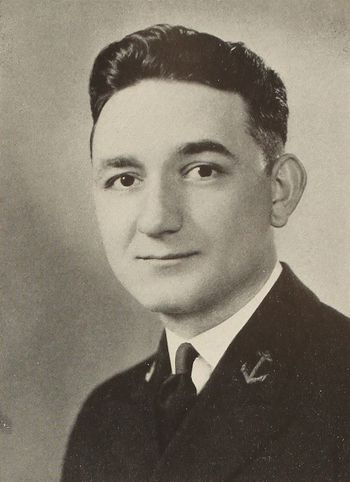JAMES P. ANDREA, LCDR, USN
James Andrea '37
Lucky Bag
From the 1937 Lucky Bag:
JAMES PAUL ANDREA
West New York, New Jersey
"Jimmie" "Paulinof"
Jimmie has the enviable faculty of being able to believe that everything happens for the best. A ready smile and an eternal song are the outward manifestations of his contented nature. His congeniality and his ability to provide entertainment under the most depressing circumstances make him a welcome guest in any circle. Dancing is not the least of Jimmie's abilities. Dim lights and rhythmic music never fail to allure him. Whatever the future may hold for Jimmie, we can be sure that his present course will lead him to the fullest enjoyment of life.
Trident Staff. One Stripe.

JAMES PAUL ANDREA
West New York, New Jersey
"Jimmie" "Paulinof"
Jimmie has the enviable faculty of being able to believe that everything happens for the best. A ready smile and an eternal song are the outward manifestations of his contented nature. His congeniality and his ability to provide entertainment under the most depressing circumstances make him a welcome guest in any circle. Dancing is not the least of Jimmie's abilities. Dim lights and rhythmic music never fail to allure him. Whatever the future may hold for Jimmie, we can be sure that his present course will lead him to the fullest enjoyment of life.
Trident Staff. One Stripe.
Loss
Jim was lost when USS Spence (DD 512) capsized and sank in Typhoon Cobra on December 18, 1944. Three hundred seventeen men were lost; only 24 of her officers and crew survived. Jim was Commanding Officer.
Jim, Spence, and the rest of the men and ships involved in Typhoon Cobra are extensively chronicled in "Down to the Sea: An Epic Story of Naval Disaster and Heroism in World War II" by Bruce Henderson.
Other Information
From "Down to the Sea":
Andrea, Jean and Judy. Wife and daughter of James P. Andrea, commanding officer, Spence. In January 1945, Jean heard on the radio that three unnamed destroyers were missing in a Pacific typhoon and hoped against hope that it was not her husband's ship. She received a telegram a short time later. Before Spence departed San Francisco for the last time, Jean had visited the ship with two-year-old Judy, who today says, "I'm told I was the apple of my father's eye." With the assistance and lifelong friendship of Arleigh Burke, Spence's former squadron commander who later became chief of naval operations, and his wife, Bobbie, Jean had a successful career working in naval intelligence at the Pentagon. She did not remarry for nineteen years. "She always said Dad was such a romantic that it was difficult for another man to measure up." Mother and daughter attended a Spence reunion in 1984, and were seated at the head table with Arleigh and Bobbie Burke. "According to Mom," says Judy (Andrea) Mahood-Cochran, "Admiral Burke quietly blamed Halsey for the loss of the three destroyers." Jean (Bailey), a widow for the second time, died in 2005 at age eighty-eight.
His wife was listed as next of kin.
James is remembered at the Manila American Cemetery and Memorial.
Remembrances
From "Down to the Sea":
Spence's future now rested with Lieutenant Commander James P. Andrea, thirty-one, of West New York, New Jersey, for whom taking command of his own ship represented the pinnacle of his naval career. Five foot nine, 160 pounds, with thick dark hair, brown eyes, and a ruddy complexion, Andrea was one of eight children born to Teresa (Favoino) and Michele Andrea, a cement mason; both came from the same region on the east coast of Italy, although they had not met until migrating to America. Growing up on the Jersey side of the Hudson River, Jim Andrea "wasn't a natural student but he studied hard and got good grades" and was his class salutatorian in high school, where he also "distinguished himself as a basketball player." After graduating at age sixteen and unable to afford college, Andrea went to work for Macy's department store for two years until receiving an appointment to the Naval Academy. Congenial and with a "keen but gentle sense of humor," Andrea made friends easily at Annapolis. "An actor on the side," he spoke several languages, loved Italian opera, and was known to sing impromptu arias. He was playfully dubbed "the Dorothy Dix of the Academy"-after the popular author of the syndicated "Dear Dorothy" advice column-due to his willingness to "listen to everyone's story." At Annapolis, Andrea did not rise to the top academically, finishing near the bottom of the class of 1937, ranked 281st out of 323 graduating midshipmen. Andrea also "almost didn't graduate" because he "couldn't swim very well." In his last Christmas home while at Annapolis, he told family members he was considering "going into the Marine Corps" after graduation, perhaps in the hope of staying on solid ground. In spite of his difficulties at the Academy, "the Navigator," as he was called by his fellow Middies for his tireless efforts to learn navigation, was described heartily in the Lucky Bag 1937, the annual of the regiment of midshipmen:
Jimmie has the enviable faculty of being able to believe that everything happens for the best. A ready smile and an eternal song are the outward manifestations of his contented nature. His congeniality and his ability to provide entertainment under the most depressing circumstances make him a welcome guest in any circle. Dancing is not the least of Jimmie's abilities. Dim lights and rhythmic music never fail to allure him. Whatever the future may hold for Jimmie, we can be sure that his present course will lead him to the fullest enjoyment of life.
Following his graduation from the Naval Academy, Andrea was assigned to the battleship Pennsylvania (BB-38). For three years he served as assistant engineering, division, and gun turret officer on the dreadnought, which took part in tactical exercises, battle practices, and fleet maneuvers in the Pacific and Caribbean. In early 1940, Andrea was transferred to the hydrographic survey ship Sumner (AG-32), then charting areas in the Caribbean and along the west coast of South America. Crew members on Sumner, where Andrea soon took over as gunnery officer after being promoted to lieutenant ( j.g.), found him to be "all Academy" but also thought "you couldn't find a nicer guy… also shipmate all around." In fact, Chief Gunner's Mate John O. Hill "named one of his sons" after the friendly young officer. In receipt of secret orders to Surabaya, Indonesia, Sumner was en route in early December 1941 when she put in briefly at Pearl Harbor. When the first bombs fell during the Japanese attack, Andrea was dressing in his small cabin to attend morning mass. At the sound of roaring airplanes and a loud explosion, he raced up on deck to direct the gun crews. One of Sumner's .50-caliber machine guns soon scored "a direct hit" on an enemy torpedo plane that was "making an approach" on Battleship Row. The aircraft "disintegrated in flames and sank in fragments" and its torpedo "sunk without exploding." In rage and frustration that morning, Andrea was "seen firing his Colt .45" sidearm at an enemy plane as it flashed by. Sumner spent the next year and a half surveying new anchorages throughout the Pacific at places such as Samoa, New Caledonia, Tonga, the New Hebrides, the Solomon Islands, and New Guinea. In July 1943, Andrea was detached from Sumner and ordered to new construction/destroyers-a highly prized assignment among junior officers. He was to put into commission and serve as executive officer of the Fletcher-class destroyer Mertz (DD-691), a new "Bath boat" about to be launched. After a shakedown cruise off Bermuda, Mertz headed for Pearl Harbor. The destroyer began convoy escort duties in March 1944 and within weeks saw her first action: attacking in a hail of 5-inch shells and sinking an enemy merchant ship. In May, Mertz returned to Pearl Harbor to prepare for the Marianas campaign, which Andrea was to miss. On May 25, after six months as Mertz's second in command, he was ordered to Spence after attending a short technical school for prospective commanding officers.
The personable style of the new Spence skipper, who was "much younger" than his predecessor and seemed to the crew "not much older than some of us," soon became evident. Andrea let it be known that he had a motto: "An efficient ship can be a happy ship." His actions showed that he also believed a happy ship could be an efficient ship. Among those appreciating Andrea's style of command was supply officer Al Krauchunas, who noticed that when Andrea went to the wardroom it was often for "a friendly visit" and not just "to talk shop." The new captain's impromptu visits were not restricted to officer country. In fact, Krauchunas judged their new commander to be "an enlisted man's skipper and a grand fellow." No one aboard Spence had any way of knowing that Andrea had in his career been warned by higher-ranking officers against becoming "too close to the crew." But that was what Torpedoman Al Rosley liked about the new skipper, finding him to be an "ordinary fellow who didn't try to rise above you." The ship newsletter was soon raving: "It would only be a waste of space to tell you that we have both the best ship and the best skipper. Who could ask for more? The height of our regard and affection is 4.0 unanimously."
There is much, much more in the book about Jim personally, professionally, and his actions before and during the typhoon.
The "Register of Commissioned and Warrant Officers of the United States Navy and Marine Corps" was published annually from 1815 through at least the 1970s; it provided rank, command or station, and occasionally billet until the beginning of World War II when command/station was no longer included. Scanned copies were reviewed and data entered from the mid-1840s through 1922, when more-frequent Navy Directories were available.
The Navy Directory was a publication that provided information on the command, billet, and rank of every active and retired naval officer. Single editions have been found online from January 1915 and March 1918, and then from three to six editions per year from 1923 through 1940; the final edition is from April 1941.
The entries in both series of documents are sometimes cryptic and confusing. They are often inconsistent, even within an edition, with the name of commands; this is especially true for aviation squadrons in the 1920s and early 1930s.
Alumni listed at the same command may or may not have had significant interactions; they could have shared a stateroom or workspace, stood many hours of watch together… or, especially at the larger commands, they might not have known each other at all. The information provides the opportunity to draw connections that are otherwise invisible, though, and gives a fuller view of the professional experiences of these alumni in Memorial Hall.
September 1937
January 1938
July 1938
January 1939
October 1939
April 1941

The "category" links below lead to lists of related Honorees; use them to explore further the service and sacrifice of alumni in Memorial Hall.